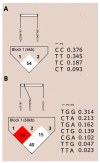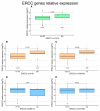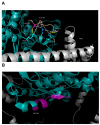Alteration of the Nucleotide Excision Repair (NER) Pathway in Soft Tissue Sarcoma
- PMID: 35955506
- PMCID: PMC9369086
- DOI: 10.3390/ijms23158360
Alteration of the Nucleotide Excision Repair (NER) Pathway in Soft Tissue Sarcoma
Abstract
Clinical responses to anticancer therapies in advanced soft tissue sarcoma (STS) are unluckily restricted to a small subgroup of patients. Much of the inter-individual variability in treatment efficacy is as result of polymorphisms in genes encoding proteins involved in drug pharmacokinetics and pharmacodynamics. The nucleotide excision repair (NER) system is the main defense mechanism for repairing DNA damage caused by carcinogens and chemotherapy drugs. Single nucleotide polymorphisms (SNPs) of NER pathway key genes, altering mRNA expression or protein activity, can be significantly associated with response to chemotherapy, toxicities, tumor relapse or risk of developing cancer. In the present study, in a cohort of STS patients, we performed DNA extraction and genotyping by SNP assay, RNA extraction and quantitative real-time reverse transcription PCR (qPCR), a molecular dynamics simulation in order to characterize the NER pathway in STS. We observed a severe deregulation of the NER pathway and we describe for the first time the effect of SNP rs1047768 in the ERCC5 structure, suggesting a role in modulating single-stranded DNA (ssDNA) binding. Our results evidenced, for the first time, the correlation between a specific genotype profile of ERCC genes and proficiency of the NER pathway in STS.
Keywords: ERCC; SNP; nucleotide excision repair (NER); pharmacogenomic; soft tissue sarcoma.
Conflict of interest statement
The authors declare no conflict of interest.
Figures









Similar articles
-
ERCC5/XPG, ERCC1, and BRCA1 gene status and clinical benefit of trabectedin in patients with soft tissue sarcoma.Cancer. 2011 Aug 1;117(15):3445-56. doi: 10.1002/cncr.25925. Epub 2011 Feb 1. Cancer. 2011. PMID: 21287534
-
Inter-individual variation in nucleotide excision repair pathway is modulated by non-synonymous polymorphisms in ERCC4 and MBD4 genes.Mutat Res. 2013 Nov-Dec;751-752:49-54. doi: 10.1016/j.mrfmmm.2013.08.005. Epub 2013 Sep 1. Mutat Res. 2013. PMID: 24004570
-
Xeroderma pigmentosum complementation group C single-nucleotide polymorphisms in the nucleotide excision repair pathway correlate with prolonged progression-free survival in advanced ovarian cancer.Cancer. 2012 Feb 1;118(3):689-97. doi: 10.1002/cncr.26329. Epub 2011 Jul 12. Cancer. 2012. PMID: 21751198
-
Pharmacogenomics of soft tissue sarcomas: New horizons to understand efficacy and toxicity.Cancer Treat Res Commun. 2022;31:100528. doi: 10.1016/j.ctarc.2022.100528. Epub 2022 Feb 1. Cancer Treat Res Commun. 2022. PMID: 35123198 Review.
-
Trabectedin: Ecteinascidin 743, Ecteinascidin-743, ET 743, ET-743, NSC 684766.Drugs R D. 2006;7(5):317-28. doi: 10.2165/00126839-200607050-00005. Drugs R D. 2006. PMID: 16922593 Review.
Cited by
-
Untargeted Metabolomics and Liquid Biopsy Investigation of Circulating Biomarkers in Soft Tissue Sarcoma.Cancers (Basel). 2025 Feb 6;17(3):553. doi: 10.3390/cancers17030553. Cancers (Basel). 2025. PMID: 39941918 Free PMC article.
-
ERCC4: a potential regulatory factor in inflammatory bowel disease and inflammation-associated colorectal cancer.Front Endocrinol (Lausanne). 2024 Mar 7;15:1348216. doi: 10.3389/fendo.2024.1348216. eCollection 2024. Front Endocrinol (Lausanne). 2024. PMID: 38516408 Free PMC article. Review.
-
Pharmacogenomic Profiling of Cisplatin-Resistant and -Sensitive Human Osteosarcoma Cell Lines by Multimodal Targeted Next Generation Sequencing.Int J Mol Sci. 2022 Oct 4;23(19):11787. doi: 10.3390/ijms231911787. Int J Mol Sci. 2022. PMID: 36233089 Free PMC article.
-
Genetic signatures of ERCC1 and ERCC2 expression, along with SNPs variants, unveil favorable prognosis in SCLC patients undergoing platinum-based chemotherapy.Oncol Res. 2024 Dec 20;33(1):45-55. doi: 10.32604/or.2024.050161. eCollection 2025. Oncol Res. 2024. PMID: 39735668 Free PMC article.
-
Association of XRCC1 (rs1799782) and XPD (rs13181) gene polymorphisms with renal failure risk in a sample of Iraqi population: a case-control study.Mol Biol Rep. 2025 Mar 8;52(1):294. doi: 10.1007/s11033-025-10408-3. Mol Biol Rep. 2025. PMID: 40056231
References
-
- Casali P.G., Abecassis N., Bauer S., Biagini R., Bielack S., Bonvalot S., Boukovinas I., Bovee J.V.M.G., Brodowicz T., Broto J., et al. ESMO Guidelines Committee and EURACAN. Soft tissue and visceral sarcomas: ESMO-EURACAN Clinical Practice Guidelines for diagnosis, treatment and follow-up. Ann. Oncol. 2018;29:iv51–iv67. doi: 10.1093/annonc/mdy096. - DOI - PubMed
-
- Antman K., Crowley J., Balcerzak S.P., E Rivkin S., Weiss G.R., Elias A., Natale R.B., Cooper R.M., Barlogie B., Trump D.L. An intergroup phase III randomized study of doxorubicin and dacarbazine with or without ifosfamide and mesna in advanced soft tissue and bone sarcomas. J. Clin. Oncol. 1993;11:1276–1285. doi: 10.1200/JCO.1993.11.7.1276. - DOI - PubMed
-
- Judson I., Verweij J., Gelderblom H., Hartmann J.T., Schöffski P., Blay J.-Y., Kerst J.M., Sufliarsky J., Whelan J., Hohenberger P., et al. Doxorubicin alone versus intensified doxorubicin plus ifosfamide for first-line treatment of advanced or metastatic soft tissue sarcoma: A randomised controlled phase 3 trial. Lancet Oncol. 2014;15:415–423. doi: 10.1016/S1470-2045(14)70063-4. - DOI - PubMed
MeSH terms
Grants and funding
LinkOut - more resources
Full Text Sources
Medical

